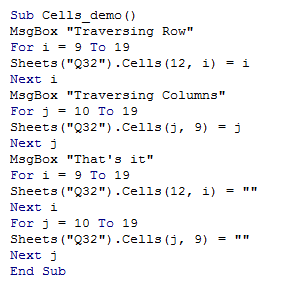VBA cells object in Excel
In the previous chapters, Range object was discussed.It is simply used to access a contigous range of cells.
The Cells object is used to access a single cell.
The Range object access a cell using its name, like A1,G7 and so on, whereas, Cells object access a cell with the help of Row and Column Index.
The Cells() comes to help, when a row has to be traversed along, with a For loop.
The Range() will be useful to traverse down a column, whereas cells() will be useful for both rows and columns.
The Syntax:
Sheets("sheet_name").Cells(row_index,col_index)
The following example illustrates this:
- Sub Cells_demo()
- MsgBox "Traversing Row"
- For i = 9 To 19
- Sheets("Q32").Cells(12, i) = i
- Next i
- MsgBox "Traversing Columns"
- For j = 10 To 19
- Sheets("Q32").Cells(j, 9) = j
- Next j
- MsgBox "That's it"
- For i = 9 To 19
- Sheets("Q32").Cells(12, i) = ""
- Next i
- For j = 10 To 19
- Sheets("Q32").Cells(j, 9) = ""
- Next j
- End Sub
As we saw from the demo, The cells method can be used to read or write data along a single row, (L9,M9,N9 and so on).
Whereas with Range, it is not easy to do the same functionality, though, it is more advantageous to read or write along a single column.
The VBA screenshot is as shown below:
